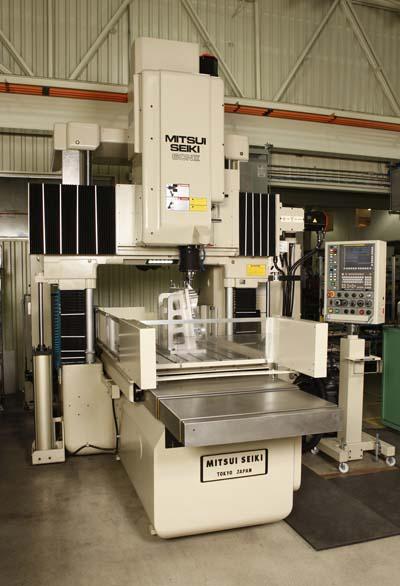
Mitsui Seiki USA Inc. announces a new service: refurbishing older Mitsui Seiki high precision jig borers. Mitsui Seiki is one of world's only remaining suppliers of jig boring machines.
"Jig borers are, in terms of accuracy, 'mother' machines, ultra precise machine tools that other machine tool builders use to make their own products," said Scott Walker, president. "They are expensive to replace. Many of our customers are choosing to rebuild versus replacing them entirely."
Milling accuracies to 2.5µm are common on a jig borer, typically one decimal point tighter than a high-end machining center. "Experienced operators can machine to tolerances of oneµm on a jig borer," said Walker.
Many jig borers can last up to 25 years before reconditioning is needed. When the machine requires attention, Mitsui Seiki can enhance, rebuild or replace several components. For example, the company typically rescrapes the table surface. A jig borer's table is essentially a master gage. It's a qualifying surface in relation to the machine and the precision workpieces. The jig borer itself is built from the master table surface, which is the only machine tool type that is constructed that way. Generally, Mitsui Seiki also refits the quill assembly, replaces spindle bearings, integrates a new Fanuc control system, rewires the electrical components, and replaces the outdated motors and drives.
Many of the jig borers at work today are used for reboring aircraft gearboxes. Typically critical gear box bores are fitted with a bushing, and then the bushing is bored back to its correct size. The flat portion of the gearbox sits on the table, and the quill feeds down exactly perpendicular to the table surface, make a perfectly round perpendicular bore to the flat side of the gear box. Machine tool builders also use jig borers for their machine tool gearboxes, pallets, and spindle housings. Jig borers are also often used to manufacture optics housings and guidance systems.
Jig borers rarely wear out completely. Therefore, Walker believes major machine tool builders are placing these rebuild orders to increase their ultra precision machining capacity. This could mean that machine tool builders are looking to achieve major improvements in the accuracy of their own equipment. Conditions in the aerospace market are contributing to this trend. Military facilities and subcontractors will rely heavily on jig boring machines to rework critical components such as gearboxes. Walker noted that similar situations exist in the commercial aircraft markets. The demand for new fuel-efficient jet engines is increasing the demand for ultraprecision machining applications to support these new component demands. New generation aircraft will also require new maintenance programs. New helicopters are contributing to the push for jig borer capabilities as well.
Contact Details
Related Glossary Terms
- boring
boring
Enlarging a hole that already has been drilled or cored. Generally, it is an operation of truing the previously drilled hole with a single-point, lathe-type tool. Boring is essentially internal turning, in that usually a single-point cutting tool forms the internal shape. Some tools are available with two cutting edges to balance cutting forces.
- bushing
bushing
Cylindrical sleeve, typically made from high-grade tool steel, inserted into a jig fixture to guide cutting tools. There are three main types: renewable, used in liners that in turn are installed in the jig; press-fit, installed directly in the jig for short production runs; and liner (or master), installed permanently in a jig to receive renewable bushing.
- flat ( screw flat)
flat ( screw flat)
Flat surface machined into the shank of a cutting tool for enhanced holding of the tool.
- gang cutting ( milling)
gang cutting ( milling)
Machining with several cutters mounted on a single arbor, generally for simultaneous cutting.
- jig
jig
Tooling usually considered to be a stationary apparatus. A jig assists in the assembly or manufacture of a part or device. It holds the workpiece while guiding the cutting tool with a bushing. A jig used in subassembly or final assembly might provide assembly aids such as alignments and adjustments. See fixture.
- jig boring
jig boring
High-precision machining (a sophisticated form of milling) that originally pertained to jig and fixture manufacturing. Basic jig-boring processes include centering, drilling, reaming, through and step boring, counterboring and contouring.
- machining center
machining center
CNC machine tool capable of drilling, reaming, tapping, milling and boring. Normally comes with an automatic toolchanger. See automatic toolchanger.
- milling
milling
Machining operation in which metal or other material is removed by applying power to a rotating cutter. In vertical milling, the cutting tool is mounted vertically on the spindle. In horizontal milling, the cutting tool is mounted horizontally, either directly on the spindle or on an arbor. Horizontal milling is further broken down into conventional milling, where the cutter rotates opposite the direction of feed, or “up” into the workpiece; and climb milling, where the cutter rotates in the direction of feed, or “down” into the workpiece. Milling operations include plane or surface milling, endmilling, facemilling, angle milling, form milling and profiling.
- precision machining ( precision measurement)
precision machining ( precision measurement)
Machining and measuring to exacting standards. Four basic considerations are: dimensions, or geometrical characteristics such as lengths, angles and diameters of which the sizes are numerically specified; limits, or the maximum and minimum sizes permissible for a specified dimension; tolerances, or the total permissible variations in size; and allowances, or the prescribed differences in dimensions between mating parts.
